高一英语教案:Reading《 A Master Of Nonverbal Humour》
- 格式:doc
- 大小:111.00 KB
- 文档页数:4
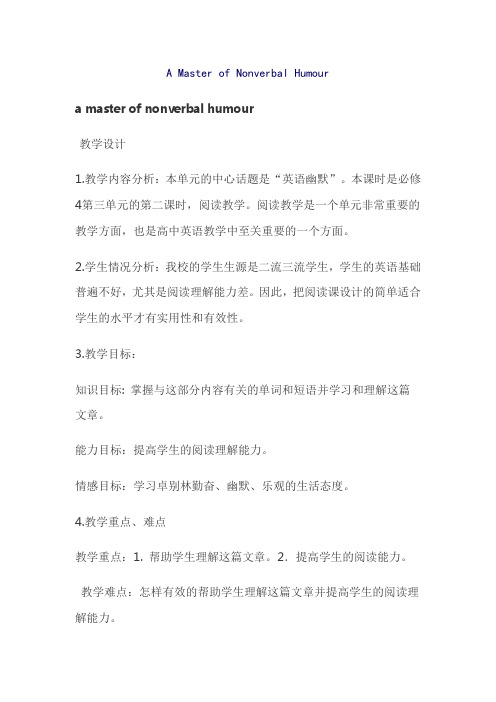
A Master of Nonverbal Humoura master of nonverbal humour教学设计1.教学内容分析:本单元的中心话题是“英语幽默”。
本课时是必修4第三单元的第二课时,阅读教学。
阅读教学是一个单元非常重要的教学方面,也是高中英语教学中至关重要的一个方面。
2.学生情况分析:我校的学生生源是二流三流学生,学生的英语基础普遍不好,尤其是阅读理解能力差。
因此,把阅读课设计的简单适合学生的水平才有实用性和有效性。
3.教学目标:知识目标: 掌握与这部分内容有关的单词和短语并学习和理解这篇文章。
能力目标:提高学生的阅读理解能力。
情感目标:学习卓别林勤奋、幽默、乐观的生活态度。
4.教学重点、难点教学重点:1. 帮助学生理解这篇文章。
2.提高学生的阅读能力。
教学难点:怎样有效的帮助学生理解这篇文章并提高学生的阅读理解能力。
5.教学过程step 1:prediction:look at the picture of charlie chaplin and read the title of the passage and predict: what is the passage about?设计意图:培养学生预测文章内容的能力。
step 2:skimmingskim the passage and match the paragraphs with the main ideas.设计意图:了解文章的段落大意有助于学生更快更好的理解文章,但让学生自己归纳段落大意对于我们这里的学生难度太大。
因此我把段落大意归纳出来,只是让学生连线,这就大大降低了难度。
step 3:scanningscan the passage and fill in the form.notes on charliechaplin’s careerborndiedjobwon an oscar设计意图:让学生在短时间内抓住人物的关键信息,有助于学生对全文的理解,并能提高学生查读信息的能力。
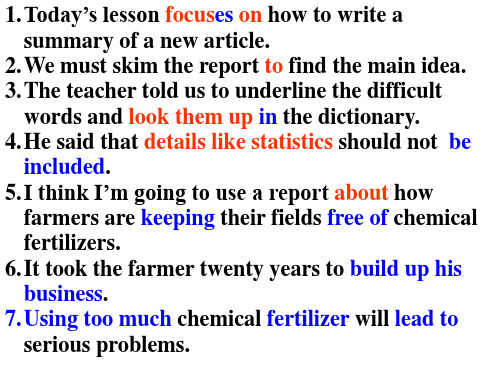
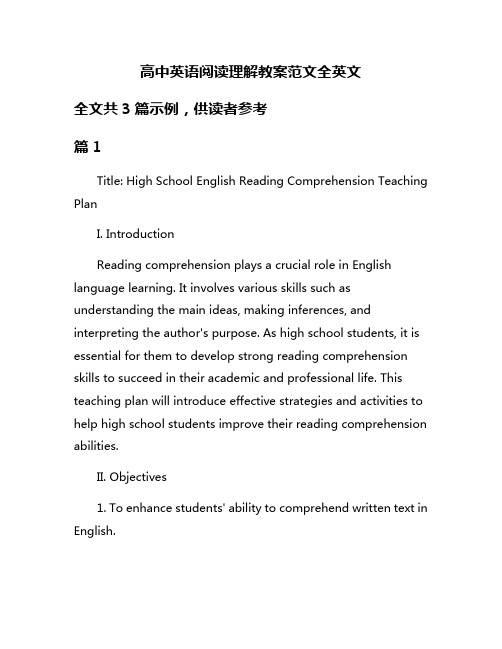
高中英语阅读理解教案范文全英文全文共3篇示例,供读者参考篇1Title: High School English Reading Comprehension Teaching PlanI. IntroductionReading comprehension plays a crucial role in English language learning. It involves various skills such as understanding the main ideas, making inferences, and interpreting the author's purpose. As high school students, it is essential for them to develop strong reading comprehension skills to succeed in their academic and professional life. This teaching plan will introduce effective strategies and activities to help high school students improve their reading comprehension abilities.II. Objectives1. To enhance students' ability to comprehend written text in English.2. To improve students' critical thinking skills through reading.3. To help students analyze and interpret different types of texts.4. To expand students' vocabulary and language proficiency.5. To develop students' confidence in reading and interpreting complex texts.III. Strategies1. Pre-reading Activities: Before reading a text, students can engage in activities such as predicting the content based on the title or images, discussing their prior knowledge on the topic, or brainstorming questions they have about the text.2. During-reading Activities: While reading, students can highlight key information, identify the main ideas and supporting details, and monitor their understanding by summarizing the text after each paragraph or section.3. Post-reading Activities: After reading, students can engage in discussions about the text, share their opinions and interpretations, answer comprehension questions, or write a summary or reflection on what they have read.4. Vocabulary Building: Introducing new vocabulary words and idioms from the text, and providing opportunities for students to use these words in context through exercises or discussions.5. Critical Thinking Exercises: Encouraging students to analyze the author's purpose, make inferences, identify biases, and evaluate the credibility of the information presented in the text.IV. Sample Lesson PlanTitle: Understanding Non-Fiction TextsObjective: To help students develop skills in comprehending and analyzing non-fiction texts.1. Warm-up (10 minutes)- Discuss the difference between fiction and non-fiction texts.- Brainstorm examples of non-fiction texts such as newspaper articles, essays, and scientific reports.2. Pre-reading Activity (10 minutes)- Show students the title and subtitles of a non-fiction article.- Ask students to make predictions about the content based on the title and subtitles.3. Reading (30 minutes)- Ask students to read the non-fiction article individually.- Encourage students to highlight key information, identify the main ideas and supporting details.- Monitor students' progress and provide support as needed.4. Post-reading Activities (20 minutes)- Divide students into small groups to discuss the main ideas of the text and share their interpretations.- Ask students to answer comprehension questions about the text.- Have students write a summary or reflection on what they have learned from the article.5. Vocabulary Building (10 minutes)- Introduce new vocabulary words from the text and discuss their meanings and usage.- Provide exercises for students to practice using the new words in sentences.6. Critical Thinking Exercise (10 minutes)- Ask students to analyze the author's purpose and identify biases in the text.- Discuss the credibility of the information presented and encourage students to form their own opinions.V. ConclusionBy implementing effective strategies and activities in teaching reading comprehension, high school students can improve their language skills, critical thinking abilities, and confidence in reading and interpreting complex texts. This teaching plan provides a framework for educators to help students develop the necessary skills to succeed in their academic and professional endeavors.篇2High School English Reading Comprehension Teaching PlanI. IntroductionReading comprehension is a vital skill for high school students to develop, as it not only enhances their academicperformance but also improves their overall language proficiency. This teaching plan aims to effectively teach high school students how to improve reading comprehension skills.II. Objectives1. To enhance students' ability to understand and interpret various types of texts.2. To improve students' vocabulary and language usage.3. To develop critical thinking skills through reading and analyzing texts.4. To help students draw connections between texts and real-life situations.III. Strategies1. Pre-reading activities: Before reading a text, engage students in activities such as brainstorming, predicting, and activating prior knowledge. This helps set the context for the text and prepares students for what they are about to read.2. During-reading activities: While students are reading a text, encourage them to use active reading strategies such as highlighting key information, making annotations, and askingquestions. This helps students stay focused and ensures better comprehension.3. Post-reading activities: After reading a text, have students engage in activities such as summarizing, analyzing, discussing, and interpreting the text. This helps reinforce comprehension and allows students to reflect on the text.IV. Lesson Plan1. Introduction to reading comprehension: Start the lesson by explaining the importance of reading comprehension and its relevance to academic success. Provide examples of how reading comprehension skills can be applied in various contexts.2. Pre-reading activity: Choose a text that is appropriate for the students' proficiency level and interests. Engage students in a pre-reading activity such as predicting the content of the text based on the title or images.3. During-reading activity: Ask students to read the text individually or in pairs and actively engage with the text by highlighting key information, making annotations, and asking questions.4. Post-reading activity: Have students discuss the text in groups, summarize the main ideas, analyze the text's structure,and draw connections to real-life situations. Encourage students to express their opinions and interpretations of the text.V. AssessmentAssess students' reading comprehension skills through various methods such as quizzes, writing assignments, class discussions, and presentations. Provide constructive feedback to help students improve their comprehension skills.VI. ConclusionReading comprehension is a crucial skill that high school students need to develop to succeed academically and in life. By implementing effective teaching strategies and engaging students in various activities, educators can help students improve their reading comprehension skills and become better readers and critical thinkers.篇3High School English Reading Comprehension Lesson PlanObjective:- To improve students' comprehension skills through reading and answering questions based on a variety of texts.- To develop students' critical thinking skills by analyzing and interpreting information from different sources.- To enhance students' vocabulary and grammar skills by exposing them to a range of reading materials.Materials:- A selection of reading passages on various topics (e.g. news articles, short stories, poems)- Reading comprehension questions for each passage- Highlighters or colored pens for marking important information- Answer keys for the comprehension questions- Whiteboard and markers for class discussionProcedure:1. Warm-up (10 minutes):- Begin the lesson by asking students to discuss in pairs or small groups about what reading comprehension means to them.- Engage the students in a short discussion about the importance of being able to understand and interpret written texts.2. Introduction to the Lesson (5 minutes):- Explain to the students that today's lesson will focus on improving their reading comprehension skills through various activities.- Provide an overview of the objectives and outcomes of the lesson to set the students' expectations.3. Reading and Comprehension Activities (40 minutes):- Divide the students into small groups and distribute the reading passages and comprehension questions.- Instruct the students to read the passage carefully, highlighting or underlining important information as they go.- Encourage students to work together in their groups to answer the comprehension questions, referring back to the text for evidence and support.- Walk around the classroom, monitoring the students' progress and providing assistance where needed.- Once the groups have completed the questions, reconvene as a class to discuss the answers and address any areas of confusion or misunderstanding.- Review the correct answers with the class and reinforce key vocabulary and grammar concepts that were covered in the passages.4. Extension Activities (15 minutes):- To further enhance the students' comprehension skills, provide additional reading passages or texts for them to work on individually or in pairs.- Encourage students to write short summaries or reflections on the texts they have read, focusing on the main ideas and key points.- Challenge the students to identify and analyze different perspectives or interpretations within the text, promoting critical thinking and analysis skills.5. Closure (5 minutes):- Conclude the lesson by reviewing the key concepts and skills that were covered during the class.- Encourage students to continue practicing their reading comprehension skills by reading regularly and engaging with a variety of texts.- Provide positive feedback and reinforcement to motivate the students and reinforce their learning.Assessment:- Assess students' comprehension skills through their responses to the reading comprehension questions and their participation in class discussions.- Monitor students' progress over time by evaluating their ability to analyze and interpret texts effectively.- Provide feedback and guidance to help students improve their reading comprehension skills and achieve their learning goals.Overall, this lesson plan is designed to help high school students develop and enhance their reading comprehension skills through engaging and interactive activities. By providing a variety of reading materials and opportunities for discussion and analysis, students will be able to improve their comprehension abilities and become more proficient readers.。

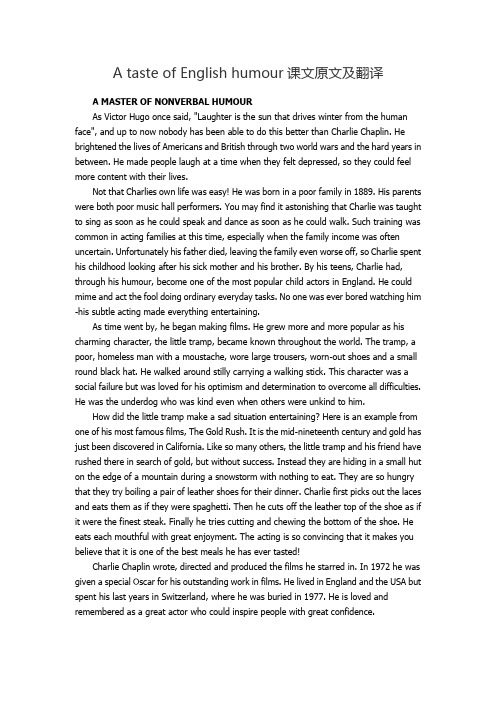
A taste of English humour课文原文及翻译A MASTER OF NONVERBAL HUMOURAs Victor Hugo once said, "Laughter is the sun that drives winter from the human face", and up to now nobody has been able to do this better than Charlie Chaplin. He brightened the lives of Americans and British through two world wars and the hard years in between. He made people laugh at a time when they felt depressed, so they could feel more content with their lives.Not that Charlies own life was easy! He was born in a poor family in 1889. His parents were both poor music hall performers. You may find it astonishing that Charlie was taught to sing as soon as he could speak and dance as soon as he could walk. Such training was common in acting families at this time, especially when the family income was often uncertain. Unfortunately his father died, leaving the family even worse off, so Charlie spent his childhood looking after his sick mother and his brother. By his teens, Charlie had, through his humour, become one of the most popular child actors in England. He could mime and act the fool doing ordinary everyday tasks. No one was ever bored watching him -his subtle acting made everything entertaining.As time went by, he began making films. He grew more and more popular as his charming character, the little tramp, became known throughout the world. The tramp, a poor, homeless man with a moustache, wore large trousers, worn-out shoes and a small round black hat. He walked around stilly carrying a walking stick. This character was a social failure but was loved for his optimism and determination to overcome all difficulties. He was the underdog who was kind even when others were unkind to him.How did the little tramp make a sad situation entertaining? Here is an example from one of his most famous films, The Gold Rush. It is the mid-nineteenth century and gold has just been discovered in California. Like so many others, the little tramp and his friend have rushed there in search of gold, but without success. Instead they are hiding in a small hut on the edge of a mountain during a snowstorm with nothing to eat. They are so hungry that they try boiling a pair of leather shoes for their dinner. Charlie first picks out the laces and eats them as if they were spaghetti. Then he cuts off the leather top of the shoe as if it were the finest steak. Finally he tries cutting and chewing the bottom of the shoe. He eats each mouthful with great enjoyment. The acting is so convincing that it makes you believe that it is one of the best meals he has ever tasted!Charlie Chaplin wrote, directed and produced the films he starred in. In 1972 he was given a special Oscar for his outstanding work in films. He lived in England and the USA but spent his last years in Switzerland, where he was buried in 1977. He is loved and remembered as a great actor who could inspire people with great confidence.无声的幽默的大师维克多o雨果曾经说过:"笑容如阳光,驱走人们脸上的冬天。
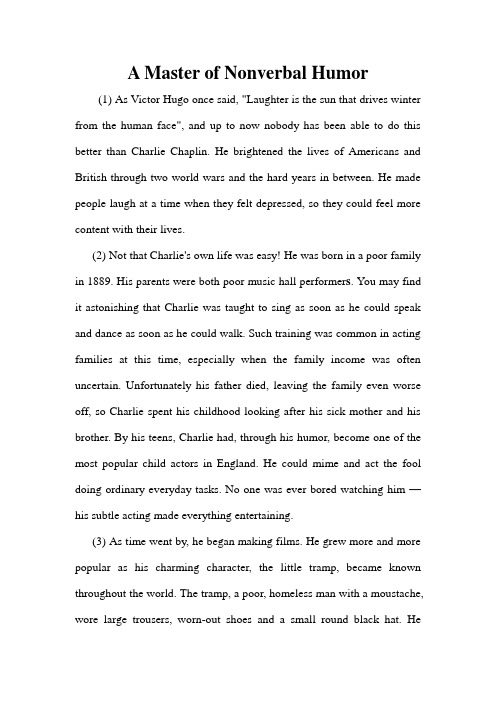
A Master of Nonverbal Humor(1) As Victor Hugo once said, "Laughter is the sun that drives winter from the human face", and up to now nobody has been able to do this better than Charlie Chaplin. He brightened the lives of Americans and British through two world wars and the hard years in between. He made people laugh at a time when they felt depressed, so they could feel more content with their lives.(2) Not that Charlie's own life was easy! He was born in a poor family in 1889. His parents were both poor music hall performer s. You may find it astonishing that Charlie was taught to sing as soon as he could speak and dance as soon as he could walk. Such training was common in acting families at this time, especially when the family income was often uncertain. Unfortunately his father died, leaving the family even worse off, so Charlie spent his childhood looking after his sick mother and his brother. By his teens, Charlie had, through his humor, become one of the most popular child actors in England. He could mime and act the fool doing ordinary everyday tasks. No one was ever bored watching him —his subtle acting made everything entertaining.(3) As time went by, he began making films. He grew more and more popular as his charming character, the little tramp, became known throughout the world. The tramp, a poor, homeless man with a moustache, wore large trousers, worn-out shoes and a small round black hat. Hewalked around stiffly carrying a walking stick. This character was a social failure but was loved for his optimism and determination to overcome all difficulties. He was the underdog who was kind even when others were unkind to him.(4) How did the little tramp make a sad situation entertaining? Here is an example from one of his most famous films, The Gold Rush. It is the mid-nineteenth century and gold has just been discovered in California. Like so many others, the little tramp and his friend have rushed there in search of gold, but without success. Instead they are hiding in a small hut on the edge of a mountain during a snowstorm with nothing to eat. They are so hungry that they try boiling a pair of leather shoes for their dinner. Charlie first picks out the laces and eats them as if they were spaghetti. Then he cuts off the leather top of the shoe as if it were the finest steak. Finally he tries cutting and chewing the bottom of the shoe. He eats each mouthful with great enjoyment. The acting is so convincing that it makes you believe that it is one of the best meals he has ever tasted!(5) Charlie Chaplin wrote, directed and produced the films he starred in. In 1972 he was given a special Oscar for his outstanding work in films. He lived in England and the USA but spent his last years in Switzerland, where he was buried in 1977. He is loved and remembered as a great actor who could inspire people with great confidence.Slide Vt. &vi.(使)滑动;(使)滑行n. 滑;滑动Content adj.满足的;满意的n. 满足Vt. 使满足Astonish Vt. 使惊讶Particular adj.特殊的;特别的n.细节;细目Throughout prep.遍及;贯穿adv. 到处;始终;全部Overcome Vt. & vi.战胜;克服;征服Fortunate adj.幸运的;吉利的Direct Vt. & vi.导演;指示;指挥Mouthful adj.一口;满口Swing Vt. & vi.摇摆;摆动;旋转n. 秋千Outstanding adj. 杰出的;显著的;未解决的;未偿付的At times 有时候Be content with 以…为满足Badly off 穷的;缺少的Pick up 拿起;捡起;拾起Star in 担任主角;主演Knock into 撞上;撞见;偶然遇见Deal with对付;应付;处理;安排。

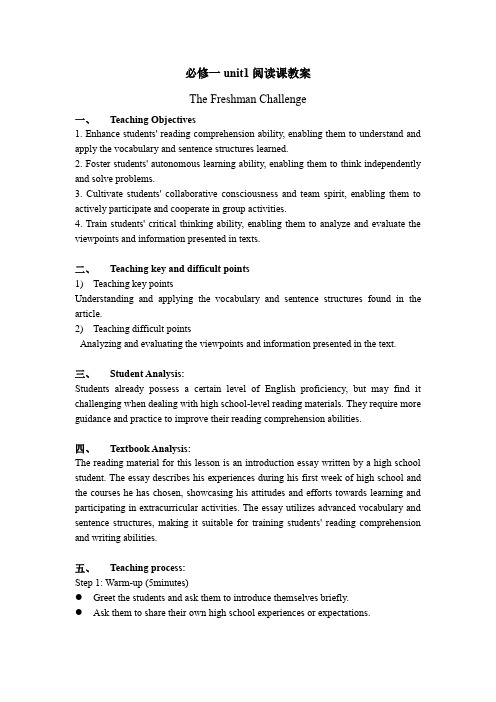
必修一unit1阅读课教案The Freshman Challenge一、Teaching Objectives1. Enhance students' reading comprehension ability, enabling them to understand and apply the vocabulary and sentence structures learned.2. Foster students' autonomous learning ability, enabling them to think independently and solve problems.3. Cultivate students' collaborative consciousness and team spirit, enabling them to actively participate and cooperate in group activities.4. Train students' critical thinking ability, enabling them to analyze and evaluate the viewpoints and information presented in texts.二、Teaching key and difficult points1)Teaching key pointsUnderstanding and applying the vocabulary and sentence structures found in the article.2)Teaching difficult pointsAnalyzing and evaluating the viewpoints and information presented in the text.三、Student Analysis:Students already possess a certain level of English proficiency, but may find it challenging when dealing with high school-level reading materials. They require more guidance and practice to improve their reading comprehension abilities.四、Textbook Analysis:The reading material for this lesson is an introduction essay written by a high school student. The essay describes his experiences during his first week of high school and the courses he has chosen, showcasing his attitudes and efforts towards learning and participating in extracurricular activities. The essay utilizes advanced vocabulary and sentence structures, making it suitable for training students' reading comprehension and writing abilities.五、Teaching process:Step 1: Warm-up (5minutes)●Greet the students and ask them to introduce themselves briefly.●Ask them to share their own high school experiences or expectations.Step 2: Reading Comprehension (15minutes)●Ask the students to read the article carefully and underline any new vocabulary orphrases they encounter.●After reading, ask the students to summarize the main idea of the article in theirown words.●Discuss the questions below to enhance comprehension:a)What are Adam's first impressions of senior high school?b)What courses does Adam choose? Why did he choose these courses?c)What extracurricular activities does Adam join? How does he feel about notbeing able to join the football team?d)What challenges does Adam face as a senior high school student? How will heovercome them?e)What does Adam hope to achieve in his studies and future career? Why?Step 3: Writing Practice (15minutes)●Ask the students to write a short paragraph about their own high schoolexperiences or expectations. They should include some personal stories or goals that they want to achieve.●Encourage them to use the new vocabulary and phrases from the article in theirwriting.●Review each student's paragraph and provide feedback on their language use andcontent.Step 4: Group Work (10minutes)●Divide the students into small groups of three or four.●Instruct each group to discuss the following question: "What advice would yougive to someone who is starting high school?" They should share their own experiences and offer suggestions based on what they learned from Adam's story.●Allow each group to present their ideas to the class and encourage others to askquestions or add their own thoughts.Step 5: Homework (5minutes)Write a short paragraph about your own high school experiences or expectations, using some of the new vocabulary and phrases from the article.。
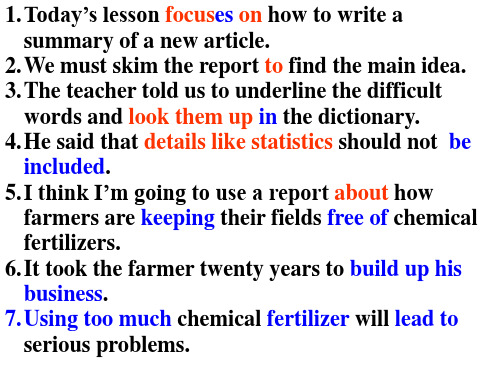
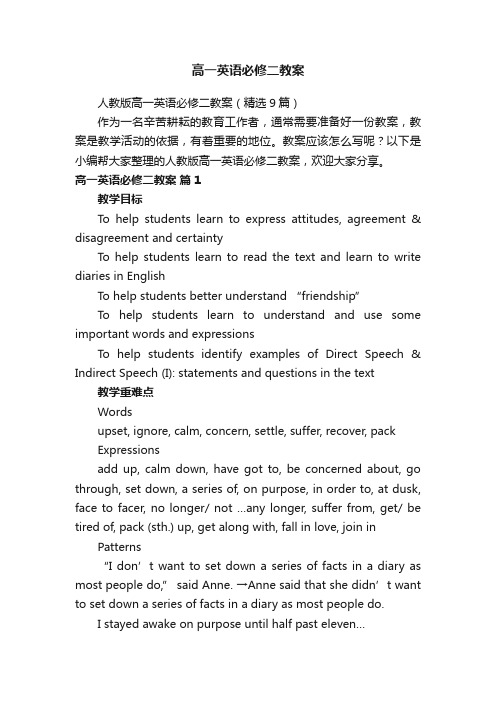
高一英语必修二教案人教版高一英语必修二教案(精选9篇)作为一名辛苦耕耘的教育工作者,通常需要准备好一份教案,教案是教学活动的依据,有着重要的地位。
教案应该怎么写呢?以下是小编帮大家整理的人教版高一英语必修二教案,欢迎大家分享。
高一英语必修二教案篇1教学目标To help students learn to express attitudes, agreement & disagreement and certaintyTo help students learn to read the text and learn to write diaries in EnglishTo help students better understand “friendship”To help students learn to understand and use some important words and expressionsTo help students identify examples of Direct Speech & Indirect Speech (I): statements and questions in the text 教学重难点Wordsupset, ignore, calm, concern, settle, suffer, recover, packExpressionsadd up, calm down, have got to, be concerned about, go through, set down, a series of, on purpose, in order to, at dusk, face to facer, no longer/ not …any longer, suffer from, get/ be tired of, pack (sth.) up, get along with, fall in love, join in Patterns“I don’t want to set down a series of facts in a diary as most peop le do,” said Anne. →Anne said that she didn’t want to set down a series of facts in a diary as most people do.I stayed awake on purpose until half past eleven……it was the first time in a year and a half that I’d seen the night face to face…教学工具ppt教学过程Hello, everyone. I’m so glad to be your teacher of English. I’d like to make friends with you, to build up a close friendship with you. Today we shall take Unit 1. The topic of this unit is Friendship. What do you think friendship is?1. Warming up⑴ Warm ing up by defining friendshipHello, everyone. I’m so glad to be your teacher of English. I’d like to make friends with you, to build up a close friendship with you. Today we shall take Unit 1. The topic of this unit is Friendship. What do you think friendship is?Yeah, there are many explanations about friendship. However, friendship is a relationship that can’t be restricted(限制)by definition(定义). It can only be experienced. True friendship can exist between any two souls, be it between people or animals. It can happen at any moment, to anyone. Even to lifeless things, like a diary, a ball, a friendship can happen.Then what is your opinion about friendship?Do you think that friendship is important to our life? Why?⑵Warming up by learning to solve problem sNice to meet you, class. We shall be friends from now on. For everybody needs friends. But being a good friend can sometimes be hard work. Learning how to solve problems in a friendship can make you a better friend and a happier person. Discuss the situation below and try to solve the problems wisely.Common problems among teenagersSolutionSome of the common problems include forgetting friends’ birthday, not keeping promises, letting out friends’ secrets and so on.Maybe we can have a heart-to-heart talk with our friends to ask for forgiveness.Situation 1: Friends get angry with each other when they try to talk about something difficult.Try to understand your friend/ Try to talk about the problem in a different way.Situation 2: Friends don’t know how to apologizeStart by telling each other that you are sorry. A simple apology is often enough and is a good starting point.Situation 3: Some friends don’t know how to keep secrets.Keep your secrets to yourselfTips on being a good friendTreat your friends the way you want to be treated. Keep secrets that are told to you.Pay attention when your friend is talking. Keep your promises. Share things with your friend. Tell your friend the truth. Stick up for your friend.⑶Warming up by doing a surveyGood morning, class. I am your teacher of English. Glad to be here with you. Today we shall take Unit 1 Friendship.To be frankly, I’d like very much to keep a close friendship with you, my dear students, in the following years. How about you then? Ok, thanks. I do hope to be your good teacher as well as your helpful friend (良师益友).Now please do the survey on page one.Add up your score according to the scoring sheet on page 8.You don’t have to tell your results. You can just keep it a secret.高一英语必修二教案篇2教学目标I. 单词和词组permission, nation,reduce, fetch, compare, therefore, remain, dislik, share, persuade, hardly, go ahead, burn down, compared to, give up, call for, be used to, get into the habit ofII. 日常交际用语1.请求May / Could / Can I do that?I wonder if I can do that.Would / Do you mind if I come earlier?Will you tell me if can go now?2.允许Yes, please. / Of course. / Sure. / Certainly.Go ahead, please.That’s all right. / OK.It’s all right to me.3.拒绝I’m sorry, but it’s not allowed here.You’d better not.I’m afraid not. It’s not right.III.语法复习名词性从句作宾语和表语的用法。

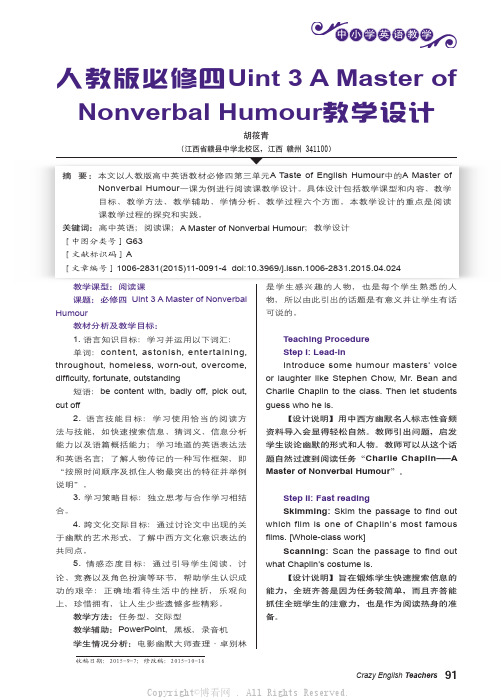
Uint 3 A Master of教学设计摘 要:本文以人教版高中英语教材必修四第三单元A Taste of English Humour中的A Master of Nonverbal Humour一课为例进行阅读课教学设计。
具体设计包括教学课型和内容、教学目标、教学方法、教学辅助、学情分析、教学过程六个方面。
本教学设计的重点是阅读课教学过程的探究和实践。
关键词:高中英语;阅读课;A Master of Nonverbal Humour;教学设计[中图分类号]G63[文献标识码]A[文章编号]1006-2831(2015)11-0091-4 doi:10.3969/j.issn.1006-2831.2015.04.02492Crazy English TeachersStep III: Detailed readingComprehending and learning about language1. Listen to the tape.2. Match the words or expressions with the correct meaning. [Individual work]①content (Para 1) a. in a poor position, esp. fi nancially ②badly off (Para 2) b. amusing or interesting ③entertaining (Para 2) c. to choose someone or sth.carefully/ to recognize someone or sth. in a group of people or things ④throughout (Para 3) d. in every part; everywhere⑤overcome (Para 3) e. to deal with and control a problem or feeling⑥homeless (Para 3) f. satis fi ed, happy, not wanting more ⑦pick out (Para 4) g. to fi ll sb. with thoughts, feelings or aims⑧inspire (Para 5) h. people have nowhere to live Suggested answers: ①f ②a ③b ④d ⑤e ⑥h ⑦c ⑧g【设计说明】通过阅读、理解,让学生自己找出有把握的正确释义。
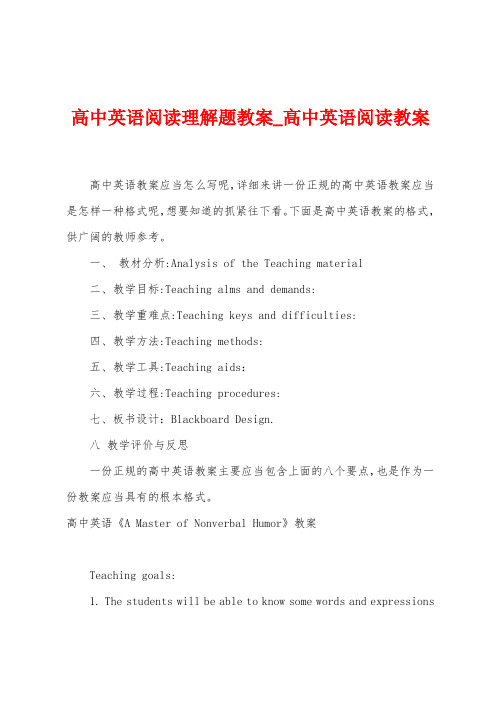
高中英语阅读理解题教案_高中英语阅读教案高中英语教案应当怎么写呢,详细来讲一份正规的高中英语教案应当是怎样一种格式呢,想要知道的抓紧往下看。
下面是高中英语教案的格式,供广阔的教师参考。
一、教材分析:Analysis of the Teaching material二、教学目标:Teaching alms and demands:三、教学重难点:Teaching keys and difficulties:四、教学方法:Teaching methods:五、教学工具:Teaching aids:六、教学过程:Teaching procedures:七、板书设计:Blackboard Design.八教学评价与反思一份正规的高中英语教案主要应当包含上面的八个要点,也是作为一份教案应当具有的根本格式。
高中英语《A Master of Nonverbal Humor》教案Teaching goals:1. The students will be able to know some words and expressionsto describe a person’s appearance.2. The students will be able to know something about Charlie Chaplin’s life experiences, charming character and convincing performance.3. The students will be able to further understand the meaning of laughter.4. The students will be able to have a better command of summarizing a short passage by picking out key words from the passage.5. The students will be able to master a framework of introducing a person.6. The students will experience the reading strategy of summarizing, analyzing, inferring, and evaluating.Teaching process:Step 1: lead-inHave a taste of English humor by introducing two letters between Albert Einstein and Charlie Chaplin.Albert Einstein:You are really great. Everyone understands your film although there is no line.Charlie Chaplin:You are even greater although nobody understands your theory.设计意图:教师用简短的语言概括了爱因斯坦和卓别林之间的一次书信交往。
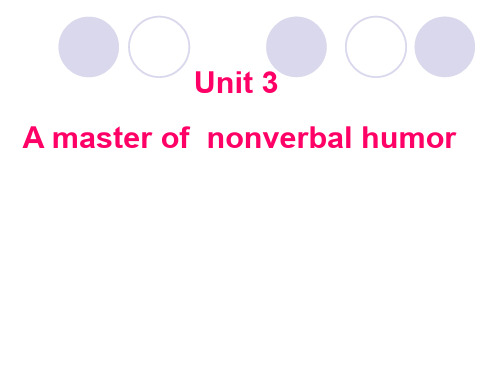
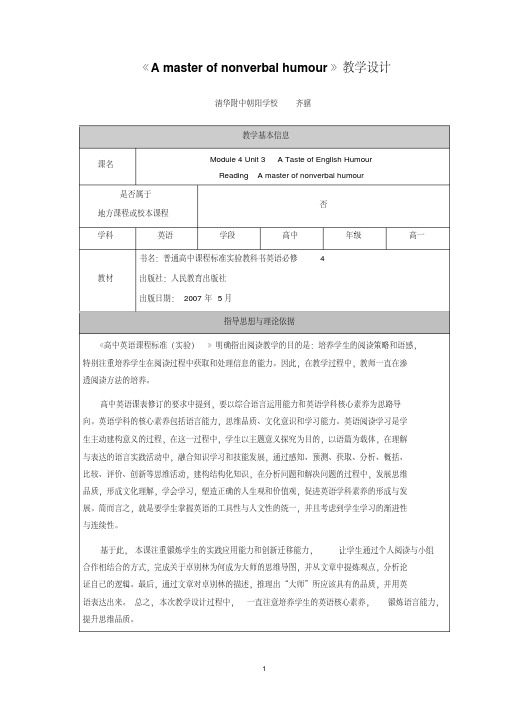
《A master of nonverbal humour》教学设计清华附中朝阳学校齐骥教学基本信息课名Module 4 Unit 3 A Taste of English HumourReading A master of nonverbal humour 是否属于地方课程或校本课程否学科英语学段高中年级高一教材书名:普通高中课程标准实验教科书英语必修 4 出版社:人民教育出版社出版日期:2007年5月指导思想与理论依据《高中英语课程标准(实验)》明确指出阅读教学的目的是:培养学生的阅读策略和语感,特别注重培养学生在阅读过程中获取和处理信息的能力。
因此,在教学过程中,教师一直在渗透阅读方法的培养。
高中英语课表修订的要求中提到,要以综合语言运用能力和英语学科核心素养为思路导向。
英语学科的核心素养包括语言能力,思维品质、文化意识和学习能力。
英语阅读学习是学生主动建构意义的过程,在这一过程中,学生以主题意义探究为目的,以语篇为载体,在理解与表达的语言实践活动中,融合知识学习和技能发展,通过感知、预测、获取、分析、概括、比较、评价、创新等思维活动,建构结构化知识,在分析问题和解决问题的过程中,发展思维品质,形成文化理解,学会学习,塑造正确的人生观和价值观,促进英语学科素养的形成与发展。
简而言之,就是要学生掌握英语的工具性与人文性的统一,并且考虑到学生学习的渐进性与连续性。
基于此,本课注重锻炼学生的实践应用能力和创新迁移能力,让学生通过个人阅读与小组合作相结合的方式,完成关于卓别林为何成为大师的思维导图,并从文章中提炼观点,分析论证自己的逻辑。
最后,通过文章对卓别林的描述,推理出“大师”所应该具有的品质,并用英语表达出来。
总之,本次教学设计过程中,一直注意培养学生的英语核心素养,锻炼语言能力,提升思维品质。
1。
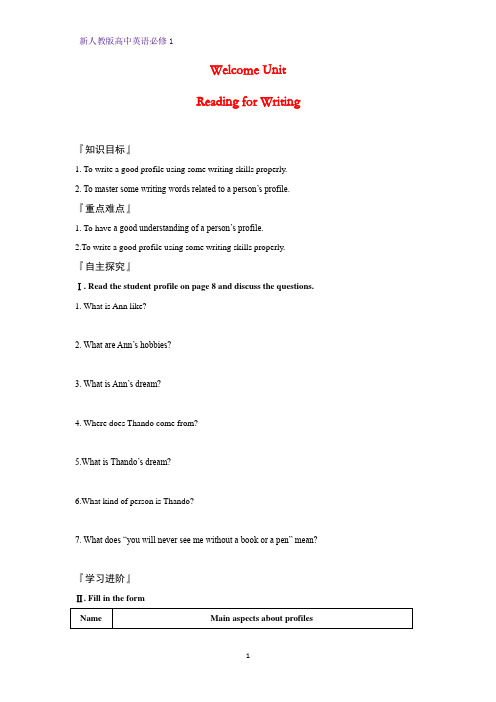
Welcome UnitReading for Writing『知识目标』1. To write a good profile using some writing skills properly.2. To master some writing words related to a person’s profile.『重点难点』1. To have a good understanding of a person’s profile.2.To write a good profile using some writing skills properly.『自主探究』Ⅰ. Read the student profile on page 8 and discuss the questions.1. What is Ann like?2. What are Ann’s hobbies?3. What is Ann’s dream?4. Where does Thando come from?5.What is Thando’s dream?6.What kind of person is Thando?7. What does “you will never see me without a book or a pen” mean?『学习进阶』Ⅱ. Fill in the form『实践探究』Ⅲ. Read to write down the phrases that Ann and Thando use to describe their personalities and the sentences that they use to describe their learning styles.Ann:Phrases that Ann uses to describe her personalitiesThe sentences that Ann uses to describe her learning styles.Thando:Phrases that Thando uses to describe his personalitiesThe sentences that Thando uses to describe his learning styles.『小试牛刀』Ⅳ. Use what you have learnt to write your own student profile.1. Complete the outline and use it to draft your student profile.OutlineYour student profile draft——★ 参考答案★——Ⅰ. Read the student profile on page 8 and discuss the questions.1. She is active, athletic, curious, and hardworking.2. Dancing and skating3. To become an engineer in the future4. South Africa5. To start his own IT computer6. He is healthy, hardworking, and smart.7. It means he is hardworking. He likes reading books and taking notes.Ⅱ. Fill in the formⅢ. Read to write down the phrases that Ann and Thando use to describe their personalities and the sentences that they use to describe their learning styles.Ann :Phrases to describe her personalities:an active person be curious aboutSentences to describe her learning styles:I often ask questions, but I learn best by doing.ThandoPhrases to describe his personalities:Think fast, play hardSentences to describe his learning styles:You will never see me without a book or a pen. If I am not in cl ass, I’m either in the library or in the computer lab.Ⅳ. Use what you have learnt to write your own student profile.1. Complete the outline and use it to draft your student profile.OutlineYour student profile draft。
Reading:A Master of Nonverbal Humour Teaching Plan
教学设计
高一级英语组
___________
___________
___________
___________
___________
Step6: Discussion(5mins)
What made Chaplin so successful?
What should we learn from him?
Step7: Homework.(1min)
Retell the passage again with your partner according to the key words.
Circle the language points in the passage, and try to understand their meanings.
Reading:A Master of Nonverbal Humour
教学反思
高一级英语组
本单元的中心话题是英式幽默,而本堂课主要通过阅读一篇文章来了解一位非言语大师——卓别林的幽默。
文中介绍了卓别林的主要成就和他的家庭背景,卓别林通过自己无声的幽默感染了几代人,让人们在困境中找到了安慰。
老师通过卓别林的生平事迹引导学生正确面对困境,从而让学生养成一种克服困难的决心和乐观豁达的态度。
本节课的教学目标和内容的设计比较合理,教学思路清晰,首先通过学生哑剧表演来进行导入,引起了学生对哑剧和卓别林兴趣。
然后通过快速阅读、细节阅读让学生掌握了文章的主旨大意和关键信息点,突出了阅读课的特色。
然后通过复述卓别林的故事梳理了知识。
最后通过对卓别林精神的讨论来感情升华,让学生笑对人生、直面困难。
课堂导入新颖,课堂气氛活跃。
通过学生的表演引入,让英语课堂贴近学生的生活。
体现了英语科目的真实性。
然后在课堂中通过小组竞争的方式调动了学生的积极性,让学生成为了课堂的主体,老师只是教学的主导。
本堂课不仅增强了学生之间的竞争和合作,同时也增强了老师和学生的合作。
老师在任务型教学法的指导下,为阅读的各个阶段设置不同难度的任务,让学生去完成。
学生能够做课堂的主人,自然而然地增强了积极主动性。
然而,本堂课也存在一些问题。
首先课前准备不够充分,导致自己对课堂内容的把握不够熟悉,表现过于紧张。
其次,课堂的设计欠缺创新性,除了引入部分的创新,对文章的挖掘不够深入,有更多可以创新的内容没能够巧妙地展现出来。
通过本次活动,我收获到了老师的帮助、同事的鼓励、学生的支持。
也让我了解到,每一种课型都有可以突破和创新的方面。
只要肯深入挖掘,就能将原本枯燥的内容变得生动而有趣。
更为重要的是:让学生积极参与课堂,让学生感受英语的魅力。
Reading:A Master of Nonverbal Humour
教学点评
评课者:高一级英语组
田秀芳老师于2017年5月19日第六节课在高一(15)班上了高一年级青年教师的青赛课。
在本节课中,田老师选择了Book4 Unit3 Reading A Master of Nonverbal Humor部分,注重培养学生的对文章的阅读和理解能力,从知识与能力,过程与方法,情感态度与价值观方面对学生有了更好的引导和渗透,把学生的简单阅读转化为能力进行了有益的培养。
现在我将从四个维度对田老师的这节课进行点评。
一、学生表现
1.课前---在老师的指导下,学生做了充分的课前预习,阅读了幽默大师---卓别林这篇文章,对这篇阅读有了初步的认识和了解。
2.课中---学生们听课认真,反应迅速,对课文知识有较好的理解;学生们勤于思考,善于交流,乐于表现。
3.课后---学生们在思维及阅读能力上均得到较好的发展。
二、教师表现
1.教师对于目标知识及技能的培养进行了清晰、多样、生动的呈现。
2.教师一直在观察学生,根据学生的动态发展适时地作出调整,并进行有针对性的指导,同时还注意到了对学生的鼓励。
教师的教学智慧在教学过程中有较好的表现。
三、课堂生态
1.田老师设置的教学目标明确,以短小的视频资料为切入点,同时对卓别林进行一个简单简介,唤起学生对卓别林的兴趣,为课文的学习起到了较好的引入作用。
而后,深挖掘的方式关注到阅读理解中不易被注意的细微之处,兼有实用性和前瞻性。
2.在教授过程中充分发挥了教师的主导作用,同时也尊重了学生的主体地位。
3.田老师采用了动态的激励性的评价机制。
4.田老师采用了丰富的教学资源,呈现了真实多样的语言环境。
四、课堂文化
1.田老师采用了形式多样的教学方法,如,任务型教学法(Step2 Fast reading),互动式教学法(Step6 Discussion),思维导图教学法(Step5 Summary)等。
2.田老师在课堂上发展了与学生间良好的关系,给予了学生充分的尊重和鼓励。
3.田老师敢于创新,凭借较高的专业素养和教学智慧,挑战了日常教学中较少在阅读中设计的区域------学生写作思维的培养,尤其在一个成绩相对较差的班级更是难能可贵。
4.田老师通过适时地鼓励和指导,有效地帮助学生更好地融入课堂,以实现其全方位的发展。
建议和反馈
1.考虑到班级的特殊性----英语基础薄弱,问题的呈现和分析的进程可适当放缓,有助于学生更为充分地对目标知识和技能进行理解和感悟。
2.不妨对学生投入更多一点的信任,在一些有挑战性节点上,让学生进行更多相互间的评价和交流,表达他们的想法,有助于师生间达成更好的合作效果。
如Retell the story.
3.减少老师的一些不好的习惯性动作,比如用手频繁调整麦克风的位置,过多走动的动作,课堂下观察学生固定在某个区域。
相信年轻的田老师经过不断的历练,会有更大的进步!。